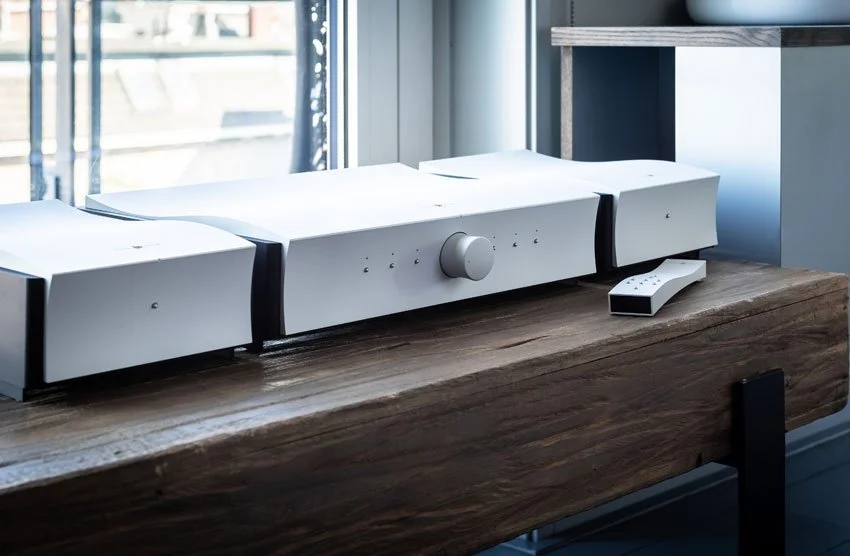Mola Mola Makua
Mola Mola Makua
Preamplifier (Optional DAC & Phono Stage)
MAKUA
ANALOGUE DESIGN FOR A DIGITAL AGE
With the knowledge in hand to design minimally invasive electronics without needing to be minimalist, Mola Mola decided that their preamp should be complete. Very complete.
The basic Makua is an extremely transparent gain stage and a programmable routing matrix. The chassis has ample room to fit optional extras, most notably a DAC and a phono stage. The 6 preset buttons are programmable via USB or Bluetooth to access any combination of channel, processing and routing. In a system with mainly digital sources, the preset buttons would be programmed to select between them. Vinyl lovers on the other hand might want to use several buttons to select the same turntable but with different EQ settings to suit their large collection of historic LP's. All five inputs are switchable between XLR and floating RCA connections, and all can be assigned as either phono or line.
All stages in the Makua use discrete amplifier modules in a little known topology called “single-ended driven differential”. Compared to doubly executed signal paths, this structure prevents noise from propagating all the way through. The Makua is amazingly immune to influences like mains quality and choice of interlinks. The relay-based volume control directly controls the gain of the output stage. Dynamic range and linearity of this arrangement is much greater than those of stepped attenuators. Operation is smooth and entirely glitch free.
Processing
Balance and input gain offset.
Phase invert and mono sum.
Optional tone control.
Full software control of routing and processing
I/O
5 balanced and 5 unbalanced inputs, all routable through optional processor boards like the phono stage.
2 parallel outputs for bi-amping.
4 programmable trigger outputs.
Performance
Distortion at maximum signal level (THD, IMD): not measurable, estimated around -150dB.
Bandwidth >200 kHz
Gain range: -70 dB to +15 dB.
Gain resolution: <1 dB, better than 0.2 dB over normal listening range.
Maximum input/output level: 20 dBu (7.75 Vrms)
Unweighted noise voltage at unity gain: 1.9 uV
Input impedance: 100 kohm
Output impedance: 44 ohm
Dimensions and Weight
420mm(W) x 110mm (H) x 345mm (D). Depth includes volume knob and connectors.
11kg
THE MOLA-MOLA MAKUA DAC: FUTURE-PROOF BY BEING FAR AHEAD.
You probably know the frustration of discovering your DAC has suddenly gone out of date because some new super chip has hit the market. Mola-Mola decided to stay out of that cycle and design, from the ground up, a discrete DAC whose unbeatable staying power results simply from being more than 10 years ahead of the performance curve. There's room enough for improvement: today’s best DAC chip claims no better than 22 bits’ worth of dynamic range and only 20 bits’ worth of linearity. High resolution music deserves better than that. Mola-Mola’s DAC is designed from the ground up using circuits and digital algorithms that were entirely developed in house.
The converter is a three board stack that fits in one of the option slots in the preamp. On the first board, all incoming digital audio is upsampled to 3.125MHz/32 bits and converted to noise shaped PWM. The two remaining boards are mono DACs, in which a discrete 32-stage FIR DAC and a single-stage 4th order filtering I/V converter convert the PWM into analogue with a breathtaking 140dB SNR. This is near the theoretical limit for 24-bit files and far beyond that of even quad-speed DSD. Uniquely, distortion remains below the noise floor even for full scale signals. A quick look at current and historic trends of high-end IC’s indicates that for the foreseeable future this kind of performance will remain unavailable to manufacturers forced to rely on the same “chip du jour” that also powers their competitors’ products.
Even by today’s exacting standards, extraordinary care has been taken deal with jitter. Mola-Mola’s DAC uses a home-grown asynchronous upsampling algorithm whose input frequency measurement slows down rapidly until after a few seconds of lock, the frequency ratio measurement is frozen. Frequency stability is then wholly determined by the internal clock, a laboratory grade 100MHz SC-cut oscillator. This is effectively an atomic clock sans the physics package (which contributes nothing to spectral purity but quite a lot to cost).
Performance
Full-Scale Output Level: 20 dBu
Signal to Noise Ratio: 140 dB (standalone version), 130dB (preamp option board)
THD, IMD: not measurable (estimated -150 dB).
Bandwidth: Up to 80 kHz. Choice of sharp or slow upsampling filters, minimum or linear phase.
Integrated jitter: <1 ps from 10 Hz upwards, <300 fs from 1 kHz upwards.
Jitter rejection: >80 dB at 1 Hz after 20 seconds of lock.
Inputs
XLR, Optical, USB and Bluetooth (A2DP)
Supported formats
PCM up to 384 kHz /32 bits (>192 kHz and >24 bits only via USB)
DSD up to quad speed (DDSD and up only via USB)
AN ARCHIVAL GRADE PHONO STAGE
Input gain is switchable in 5dB steps over a 40dB range. Input resistance and capacitance are individually switchable. Available EQ settings cover practically all known cutting curves ever used, including most 78RPM.
All settings are software controllable, either on the fly using a PC or tablet computer or directly stored under the preset buttons. And since the preamp can route any input through the phono stage, only one is needed even if you have multiple turntables and elements connected.
What was originally intended to be a simple RIAA add-on for the Makua Preamp has quickly spiraled into the quietest and probably most versatile phono stage ever built.
MC/MM input stages are optimized for current noise and voltage noise respectively. Unlike the more common arrangement of an MC head amp feeding into the MM stage, the two stages are fully independent, realising an equally short signal path for both.
Key FEATURES
Available time constants
t1: 200, 250, 318, 400, 450 us
t2: 50, 64, 75, 100 us
bass shelf: 14, 18, 20dB
Performance
Input noise (MC): 0.35 nV/rtHz
Input noise (MM): 0.9 pA/rtHz
Sensitivity: variable from 30 uV to 5 mV
THD, IMD: not measurable
RIAA conformance: +/-0.1 dB.
REVIEWS AND AWARDS
“The Mola Mola Makua phono stage is about the cleanest, least colored, most linear phono preamplifier I’ve ever heard. I found no situation in which it was anything but dead silent and supremely dynamic... High end is pure and clean and open. It’s not dry, but is open and insightful with a sense of headroom and height to the soundstage that instrumentation-style solid state often doesn’t have. Nothing is antiseptic or clinical about this presentation, even though the Makua is highly detailed and neutral...
...I challenge you to find a preamp which sounds significantly better and not merely different, for anywhere close to the price.”
Further information available at the manufacturer website or alternately give us a call or email to discuss your needs or organise an audition.











